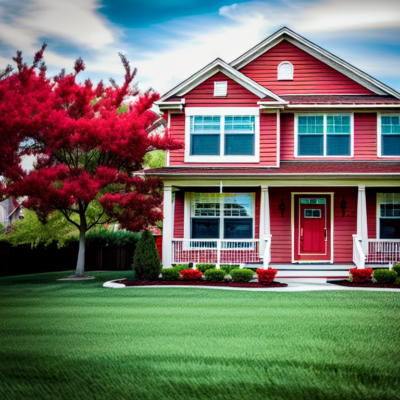10 Red Flags to Look for in a Potential Home
Searching for a new home is an exciting endeavour, but it’s important to approach it cautiously. Buying a home is a significant investment, and you want to ensure that the property you choose is in good condition and will provide a safe and comfortable living environment for you and your family.
To help you make an informed decision, we’ve compiled a comprehensive guide of the top 10 red flags to look out for when considering a potential home purchase. You can avoid costly repairs, surprises, and buyer’s remorse by thoroughly inspecting these areas.
You should also always consider having a home inspection or, at the very least, having experienced tradespeople accompany you on a visit to the home before making an offer to purchase.
Structural Integrity
The structural integrity of a home is crucial for its long-term stability. Start by examining the foundation for any visible cracks inside and outside the house. Look for signs of unevenness in the floors or doors that don’t close properly, as these could be indicators of foundation issues. Additionally, check the walls and ceilings for any cracks or signs of structural movement. If you notice any major concerns, hiring a professional inspector or structural engineer to assess the situation and provide expert advice is highly recommended.
Water Damage
Water damage is one of the most common and expensive problems homeowners face. Look for water stains on walls, ceilings, or floors and any areas of peeling paint or wallpaper. Musty odours and discoloured patches on surfaces can also indicate hidden water damage. Pay attention to the basement or crawl spaces for signs of flooding or excessive moisture. Additionally, inspect bathrooms, kitchens, and laundry areas for any signs of leaks or water damage around plumbing fixtures. Water damage can lead to mould growth, rot, and compromised structural integrity, so it’s important to investigate and address any issues thoroughly.
Plumbing Problems
Faulty plumbing can cause significant headaches and expensive repairs. Turn on faucets and showers during your visit to check the water pressure and ensure they function properly. Flush toilets to confirm they are in good working condition. Look for signs of leaks under sinks, near plumbing fixtures, or on ceilings below bathrooms. Inadequate drainage or slow-draining sinks can also be indications of plumbing issues. While some plumbing problems may be minor and easily fixable, others could require costly repairs, so it’s essential to identify any concerns before committing to a purchase.

10 Red Flags to Look for in a Potential Home
>>>> Watch Us On YouTube
>>>> Follow Us On Instagram
>>>> Find Us On Facebook
MORE BLOG POSTS HERE >>>>Elevate Blog
Electrical System Hazards
Electrical issues can pose serious safety risks and lead to fire hazards. Look for outdated or exposed wiring, particularly in older homes. Flickering lights, frequently tripped circuit breakers, or outlets that don’t work properly may be signs of electrical problems. Insufficient outlets, the excessive use of extension cords, or overloaded power strips can indicate an inadequate electrical system. It’s crucial to have a professional electrician assess the electrical system to ensure it is up to code and does not pose any safety risks.
Pest Infestations
Unwanted pests can cause significant damage to a home’s structure and compromise your well-being. Look for signs of pests, such as droppings, gnawed wood, or chewed electrical wires. Pay close attention to the kitchen, basement, and attic, as these areas are particularly susceptible to infestations. Check for cracks or openings in the walls, floors, or foundations that could serve as entry points for pests. Engaging a professional pest inspector can help you determine the severity of any infestations and provide guidance on treatment and prevention.
Roofing Problems
A compromised roof can lead to extensive water damage and costly repairs. Start by examining the roof from the ground for any visible signs of damage, such as missing, damaged, or curling shingles. Look for water stains on ceilings or walls, indicating roof leaks. Pay attention to the age and condition of the roof. If the roof is older or shows signs of wear, consider hiring a professional roofer to conduct a thorough inspection. They can provide insights into the roof’s lifespan and potential repair or replacement costs.
Insufficient Insulation
Inadequate insulation can result in uncomfortable living conditions and high energy bills. Check for drafty areas near windows and doors, indicating poor insulation. Assess the thickness and quality of insulation in the attic and walls. Proper insulation is essential for maintaining a comfortable indoor environment and reducing energy consumption. If the home appears to have insufficient insulation, consider the potential costs of upgrading it to meet your desired energy efficiency standards.
Neighbourhood and Location Concerns
While the home’s condition is vital, the neighbourhood and location significantly affect your overall satisfaction and property value. Research the neighbourhood’s crime rates, proximity to schools, amenities, and transportation options. Consider factors such as noise levels, traffic congestion, and potential future developments that may affect your quality of life. Visit the neighbourhood at different times of the day to gain a better understanding of the surroundings. Assessing whether the location aligns with your lifestyle and long-term plans is important.
Unpermitted Renovations
Be cautious of any unpermitted renovations or additions made to the home. These modifications may not have undergone the necessary inspections or met the local building codes. Unpermitted work can create complications regarding insurance coverage, property value assessment, and future legal compliance. Look for signs of renovations, such as room additions, finished basements, or updated electrical systems, that may not have proper permits or documentation. Consult with a real estate professional or local building authority to address any concerns regarding unpermitted work.
Foundation Surroundings
Inspecting the surroundings of the foundation can provide valuable insights into potential issues. Look for excessive moisture around the foundation, which could indicate poor drainage or grading problems. Check for signs of erosion or water pooling near the house, as these issues can impact the stability of the foundation. Considering the overall landscape and its potential impact on the property’s long-term integrity is important.
Conclusion
When purchasing a home, conducting a thorough inspection is crucial to identify any red flags that may indicate significant problems. By paying attention to structural integrity, water damage, plumbing and electrical systems, pest infestations, roofing, insulation, neighbourhood concerns, unpermitted renovations, and foundation surroundings, you can make an informed decision and avoid potential headaches and costly repairs. Remember, professional inspections are invaluable in assessing the condition of a property, so consider hiring experts to provide a comprehensive evaluation. With careful observation and due diligence, you’ll be well on your way to finding a safe and sound investment for your future.

Elevate Real Estate Team
Happy Home Buying or Selling
Are you thinking of making a move soon?
How can we elevate your real estate experience?
Potential Next Steps >>>
- Get a FREE online home evaluation: Free Home Evaluation
- Book a free in-home consultation: Contact Us
- Learn more about Elevate Real Estate Group: About Us
- Could you leave us a Google Review: Google Review
Want more details on the current market? You can find more information about the current market here: London & St Thomas Association of Realtors.



